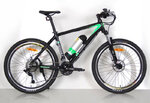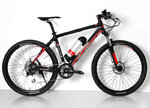Hi Anthony! Great question... As more and more electric bikes
wind up on Amazon, Walmart and other sites it's tempting to go for the lower price but kind of unsettling if you're new to the space. The first ebike I ever got was purchased online and unfortunately turned out to be a bad experience which is part of what inspired me to make this site... Not all web purchased ebikes are bad and I'm all for saving money but there's more at play here than just the bike. A warranty, informed population (who will want to buy your used bike if you decide to sell it someday) and shops that can or are willing to service the bike are also important. Hopefully I can shed some light on these Karma bikes as I have actually seen the before, off Amazon, and I've even spoken with the owners a time or two but never met them in person.
Here are some initial thoughts: These Karma bikes range from $1,897 to $3,995 on Amazon but are much more on the "official" website I've found. There, the Karma 38 costs $3,495 and appears to be the same thing. I have no idea why the price is so different, maybe they are trying to clear old inventory? It could be a knock off but considering the name is similar and even the company, it seems legit. S my point here is that these bikes are not inexpensive by comparison to leading ebikes from established brands like
Pedego,
Easy Motion or
IZIP by Currie. I think what you're getting here is the light weight carbon design and that's why it costs so much.
It looks like the Karma bikes are sold by
ST-Cycle which is new on Amazon with zero feedback (at the time of this response) but they do have their own website off of Amazon at
(Link Removed - No Longer Exists) (again I could be wrong but the logos on the site say ST-Cycle. I'm going to take a screenshot of their contact page and paste it below so you can reach out to them and see the ST logo in case the site changes someday. Also note the 2012 copyright... time to update the site guys!
View attachment 114
Whether you choose to buy one of their bikes or another online special, it's important to understand that a lot of bicycle shop owners feel betrayed by people who visit their shop and ask questions "showrooming" then go online to save $100 from a website, only to bring it in for service later expecting help. I'm not saying this is wrong, it's the reality of disruptive technology, ecommerce and globalization but it is something worth considering as ebikes tend to get ridden more often and for further distances than traditional bikes which means service and maintenance support will eventually become an issue. Servicing a foreign ebike puts shops in a tough position because they may not have the parts or experience to really help the customer and may thus have to charge more for maintenance and not be able to honor your warranty. Of course, this situation also frustrates the end user and everyone ends up having a bad ebike experience... which sucks.
Okay, so all of that "general advice" aside, there are some amazing mostly-online brands that I've come across including
Volton,
Motiv and
Juiced Riders that I trust and would still buy from, even with the service challenges that might come up. I've met these guys in person, toured their facilities and seen them branching out to dealers. This is even true of
ProdecoTech, though I'm not as much a fan of their current battery and motor designs (not super stable, and I've heard complaints from shops about customers having issues). So I'm trying to present you with an unbiased perspective here and offer support to smaller brands who are trying to get their foot in the door of this industry.
So now if we look at the Karma ebikes (which I have not ridden) I can say I've seen similar designs with the "canister battery" that attaches like a water bottle to the downtube. Heres a review of one I liked called the Falcon 350 that's somewhat comparable, again coming from a mostly-online dealer in Canada. I think the majority of these bikes are made inexpensively in Asia and then rebranded as they get shipped out to storefronts around the world who offer them as less expensive alternatives. This is fine, most stuff is made in Asia these days even for the big guys like Specialized, but quality control can sometimes become an issue vs. larger companies that send reps over to inspect and approve hardware more frequently.
So here's what I've gathered that is the same on both bikes:
- Weight ~44lbs (most ebikes with hub motors and suspension weigh ~50lbs)
- Two frame sizes, a small/medium at 16" and a medium/large at 18" serving riders 5'0" to 5'7" and then 5'8" to 6'2" respectively.
- Uses standard 26" sized wheels (some new mountain bikes run large 29" or 27.5" to split the difference, improving rolling efficiency and absorbing bump but with a hub motor design larger wheels decrease mechanical leverage and thus reduce torque).
- LCD computer offering speed, wattage, battery life indicator and pedal assist mode with 0 being no-power and 1-5 being 20% increments of power up to 100% power.
- Both bikes use pedalec sensors to detect crank movement and signal the drive system to power on or off. These are less fluid than torque sensors but require less pressure to activate. They tend to require more time to switch on and off and have been described as "jerkier" by some riders.
- Canister based Lithium-ion batteries that lock to the frame using a key but do not require the key to be left in when riding. Aluminum body is rugged, can be charged on or off the frame for convenience, takes up the spot where a water bottle cage might mount (no other places to mount one but you could add your own) and this design keeps weight low and centered on the bike frame.
- Both bikes employ a “T-Angular” tube design for their frame that's built with 3k high module (HM) carbon fiber (this refers to the stiffness of the carbon, HM is in the middle of intermediate and ultra high and can use a "medium" amount of carbon to make the bike adequately stiff and thus keep the frame relatively light weight. More info here)
- Front and rear Tektro hydraulic disc brakes (offer precision braking control with just one or two fingers of force and thus create less fatigue and are preferred for mountain biking or other high-brake applications)
- Upgraded KCM chain that's designed to be light weight, mud shedding and extra durable for offroad applications.
- RockShox suspension fork with lockout (RockShox is now a part of SRAM, these shocks looks like they might offer 100mm travel and use air and spring since the bikes are so light)
- 36 volt geared hub motor by 8Fun (they don't say how many watts the motors are... which is super frustrating, I'm guessing 350 which is average in the world of ebikes)
- Both ebikes use trigger shifters to change gears and have levers on the left and right handle bars.
Here's what I gathered that's unique to the Karma38:
- Smaller LCD computer located on left handle bar with integrated buttons, non-removable.
- SRAM crank and derailleurs with 3 by 8 setup (28 speeds).
- RockShox suspension fork with lockout (looks like 100mm travel with springs).
- 26" AW rims with studded Kenda tires.
- Aluminum seat post with standard Velo sattle.
- 36 volt 9 amp hour Lithium-ion battery for a 25 to 35 mile range, ~1.5 hours worth of ride time depending on terrain, weather, rider and use of pedal assist (higher vs. lower settings).
- Charge time of ~4 hours from empty.
And here's what I gathered that's unique to the Karma42:
- Larger LCD King Meter LCD (adjustable up or down to decrease glare) located in the center with break out button console, non-removable.
- Shimano Alivio crank and derailleur with 3 by 8 setup (28 speeds).
- 26" Alex rims with studded Kenda tires.
- Carbon seat post and Italian Prologo saddle.
- 36 volt 11.6 amp hour Lithium-ion battery for a 30 to 45 mile range, ~2 hours worth of ride time depending on terrain, weather, rider and use of pedal assist (higher vs. lower settings).
- Charge time of ~7 hours from empty.
And here are the main differences between the two ebikes that I see along with my overall thoughts: If you pay a bit more for the Karma 42 you'll shed a couple pounds of weight, get slightly better components and a larger capacity battery pack that can go a bit further per charge. Both of these bikes look pretty solid to me and I do like how the drive system has been integrated. I wish they would come out and say how many watts the hub motors are but my guess is 350 and considering they are geared and so light weight, this is decent. Since both models are setup for mountain biking they have a more aggressive seating position which could be jarring on your back or neck if you're not used to that... since ebikes also get ridden faster and further (on average) the jarring and associated soreness can be exacerbated. Consider a
seat post shock or a new stem and handle bars in this case. Neither bike has a throttle which means you'll always have to pedal and make a couple of oscillations before the pedelec will kick in (this can be a pain if you stop at a light or a stop sign going up hill and forget to shift down with your gears).
To cap it all off, here's a video review and ynbixung by someone who must have bought the Karma ST 42 online and wanted to share so people like us could see if it's worth it. They seem pretty jazzed, it looks like a nice bike and most of the components are standard so any shop should be able to do basic bicycle service... just question the motor/battery service. There's no mention of warranty on Amazon or the ST Bicycle website. In this video, note the extra steps of moving the package and assembling the bike, this is true of most ebikes purchased online.
Hope this helps you out, let me know if you have any follow up questions and if you do get one of these bikes, I'd love to hear how it works out for you and maybe see some pictures!






